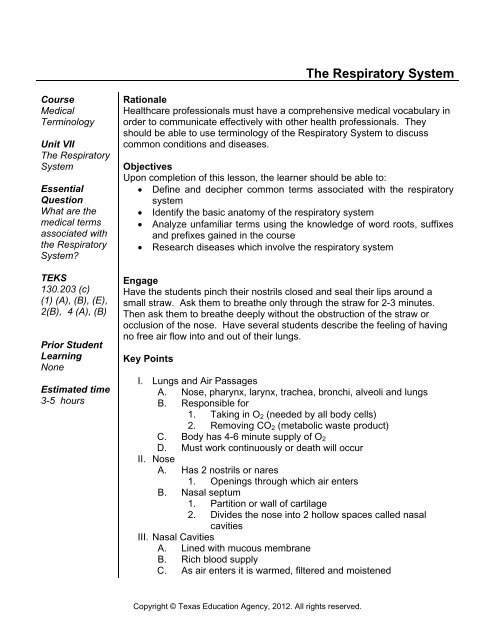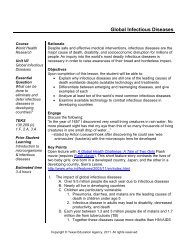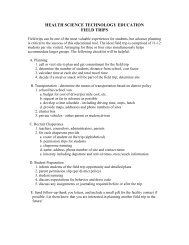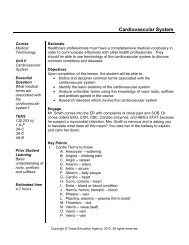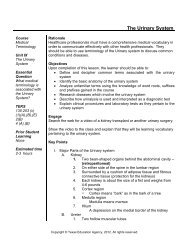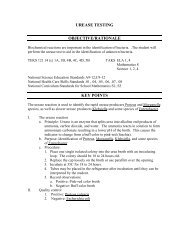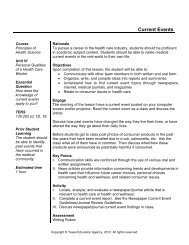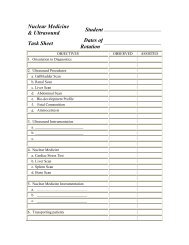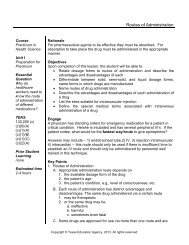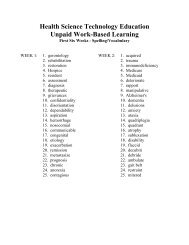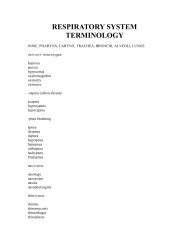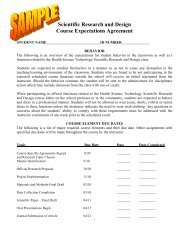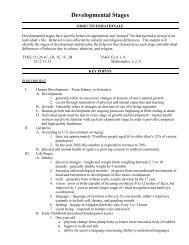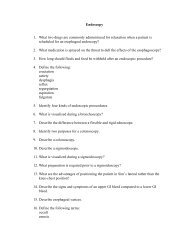The Respiratory System - Health Science Technology Education
The Respiratory System - Health Science Technology Education
The Respiratory System - Health Science Technology Education
Create successful ePaper yourself
Turn your PDF publications into a flip-book with our unique Google optimized e-Paper software.
Course<br />
Medical<br />
Terminology<br />
Unit VII<br />
<strong>The</strong> <strong>Respiratory</strong><br />
<strong>System</strong><br />
Essential<br />
Question<br />
What are the<br />
medical terms<br />
associated with<br />
the <strong>Respiratory</strong><br />
<strong>System</strong>?<br />
TEKS<br />
130.203 (c)<br />
(1) (A), (B), (E),<br />
2(B), 4 (A), (B)<br />
Prior Student<br />
Learning<br />
None<br />
Estimated time<br />
3-5 hours<br />
Copyright © Texas <strong>Education</strong> Agency, 2012. All rights reserved.<br />
<strong>The</strong> <strong>Respiratory</strong> <strong>System</strong><br />
Rationale<br />
<strong>Health</strong>care professionals must have a comprehensive medical vocabulary in<br />
order to communicate effectively with other health professionals. <strong>The</strong>y<br />
should be able to use terminology of the <strong>Respiratory</strong> <strong>System</strong> to discuss<br />
common conditions and diseases.<br />
Objectives<br />
Upon completion of this lesson, the learner should be able to:<br />
• Define and decipher common terms associated with the respiratory<br />
system<br />
• Identify the basic anatomy of the respiratory system<br />
• Analyze unfamiliar terms using the knowledge of word roots, suffixes<br />
and prefixes gained in the course<br />
• Research diseases which involve the respiratory system<br />
Engage<br />
Have the students pinch their nostrils closed and seal their lips around a<br />
small straw. Ask them to breathe only through the straw for 2-3 minutes.<br />
<strong>The</strong>n ask them to breathe deeply without the obstruction of the straw or<br />
occlusion of the nose. Have several students describe the feeling of having<br />
no free air flow into and out of their lungs.<br />
Key Points<br />
I. Lungs and Air Passages<br />
A. Nose, pharynx, larynx, trachea, bronchi, alveoli and lungs<br />
B. Responsible for<br />
1. Taking in O2 (needed by all body cells)<br />
2. Removing CO2 (metabolic waste product)<br />
C. Body has 4-6 minute supply of O2<br />
D. Must work continuously or death will occur<br />
II. Nose<br />
A. Has 2 nostrils or nares<br />
1. Openings through which air enters<br />
B. Nasal septum<br />
1. Partition or wall of cartilage<br />
2. Divides the nose into 2 hollow spaces called nasal<br />
cavities<br />
III. Nasal Cavities<br />
A. Lined with mucous membrane<br />
B. Rich blood supply<br />
C. As air enters it is warmed, filtered and moistened
D. Mucous also helps trap pathogens and dirt<br />
E. Cilia: tiny hair-like structures which also trap dirt and<br />
pathogens, pushing them toward the esophagus to be<br />
swallowed<br />
F. Olfactory receptors for the sense of smell<br />
G. Nasolacrimal ducts drain tears from the eye into the nose to<br />
provide additional moisture for the air<br />
IV. Paranasal Sinuses<br />
A. Hollow air-containing spaces within the skull<br />
B. Cavities in the skull around the nasal area<br />
C. Connected to the nasal cavity by short ducts<br />
D. Lined with mucous membrane that warms and moistens air<br />
E. Provide resonance for the voice<br />
V. Pharynx<br />
A. <strong>The</strong> throat<br />
B. Lies directly behind the nasal cavities<br />
C. As air leaves the nose it enters the pharynx<br />
D. Has three sections<br />
1. Nasopharynx<br />
a. Upper portion behind the nasal cavities<br />
b. Contain the pharyngeal tonsils or adenoids<br />
(lymphatic tissue) and the auditory (eustachian)<br />
tube openings<br />
2. Oropharynx<br />
a. Middle section located behind the oral cavity<br />
b. Contains the palatine tonsils (two rounded<br />
masses of lymphatic tissue)<br />
c. Received both air from the nasopharynx and food<br />
and air from the mouth<br />
3. Laryngopharynx<br />
a. Bottom section of the pharynx<br />
b. Branches into the trachea, which carries air to<br />
and from the lungs, and the esophagus – the<br />
tube that carries food to the stomach<br />
VI. Epiglottis<br />
A. A flap of cartilage attached to the root of the tongue<br />
B. Prevents choking or aspiration of food<br />
C. Acts as a lid over the opening of the larynx<br />
D. During swallowing when food and liquid move through the<br />
throat, the epiglottis closes over the larynx<br />
VII. Larynx<br />
A. Voice box<br />
B. Lies between the pharynx and trachea<br />
C. Has a framework of cartilage commonly called the “Adam’s<br />
apple”<br />
D. Contains two folds called vocal cords<br />
Copyright © Texas <strong>Education</strong> Agency, 2012. All rights reserved.<br />
Page 2 of 37
1. Opening between the vocal cords is the glottis<br />
2. As air leaves the lungs, the vocal cords vibrate and<br />
produce sound<br />
3. Tongue and lips act on the sound to produce speech<br />
VIII. Trachea<br />
A. Windpipe<br />
B. Tube extending from the larynx to the center of the chest<br />
(about 4.5” long)<br />
C. Carries air between the pharynx and bronchi<br />
D. Series of c-shaped cartilages, which are open on the dorsal or<br />
back surface, and help keep the trachea open<br />
IX. Bronchi<br />
A. Two divisions of the trachea near the center of the chest<br />
1. Right and left bronchus (singular)<br />
2. Right bronchus is shorter, wider and extends more<br />
vertically than the left bronchus<br />
B. Each bronchus enters a lung and carries air from the trachea to<br />
the lungs<br />
C. In the lungs, the bronchi continue to divide into smaller and<br />
smaller bronchi<br />
D. Smaller branches are called bronchioles<br />
E. Smallest bronchioles, called terminal bronchioles; end in the air<br />
sacs called alveoli<br />
X. Alveoli<br />
A. Air sacs that resemble a bunch of grapes<br />
B. Adult lung contains approximately 300 million alveoli<br />
C. Made of one layer of squamous epithelium tissue<br />
D. Contains a rich network of blood capillaries<br />
E. Capillaries allow O 2 and CO2 to be exchanged between the<br />
blood and the lungs<br />
F. Inner surface of alveoli are covered with surfactant<br />
1. Lipid or fatty substance<br />
2. Helps prevent alveoli from collapsing<br />
XI. Erythrocytes<br />
A. Carry oxygen to all parts of the body<br />
B. Carries carbon dioxide to the lungs for exhalation<br />
XII. Lungs<br />
A. Organs that contain divisions of the bronchi and alveoli<br />
B. Right lung has 3 sections or lobes: superior, middle and<br />
inferior<br />
C. Left lung has only two lobes, superior and inferior<br />
D. Left lung is smaller because the heart lies more to the left side<br />
of the chest<br />
E. Both the lungs are located in the thoracic cavity<br />
F. Apex: uppermost part of the lung<br />
G. Base: lower part of the lung<br />
Copyright © Texas <strong>Education</strong> Agency, 2012. All rights reserved.<br />
Page 3 of 37
H. Hilum: the midline region in which blood vessels, nerves,<br />
lymphatic tissue, and bronchial tubes enter and exit the lung<br />
I. <strong>The</strong> lungs extend form the collarbone to the diaphragm<br />
XIII. Diaphragm<br />
A. A muscular partition<br />
B. Separates the thoracic from the abdominal cavity<br />
C. Aids in the process of breathing<br />
1. Contracts<br />
a. Moves downward, enlarging the area in the<br />
thoracic cavity<br />
b. Decreasing internal air pressure, so that air flows<br />
into the lungs to equalize the pressure<br />
2. Relaxes<br />
a. When the lungs are full, the diaphragm relaxes<br />
and elevates<br />
b. Makes the area in the thoracic cavity smaller,<br />
thus increasing air pressure in the chest<br />
c. Air is expelled out of the lungs to equalize<br />
pressure<br />
XIV. Pleura<br />
A. Consists of two layers<br />
1. Visceral pleura attached to surface of lung; inner layer<br />
closer to the lungs<br />
2. Parietal pleura attached to the chest wall; outer layer,<br />
closer to the ribs<br />
B. Pleural space<br />
1. Located between the two layers<br />
2. Filled with a thin layer of pleural fluid that lubricates the<br />
membranes and prevents friction as the lungs expand<br />
during breathing<br />
XV. Pathway of Air<br />
A. Nose<br />
B. Nasal cavities and paranasal sinuses<br />
C. Pharynx (adenoids and tonsils)<br />
D. Larynx (epiglottis)<br />
E. Trachea<br />
F. Bronchi<br />
G. Bronchioles<br />
H. Alveoli<br />
I. Lung capillaries<br />
XVI. Ventilation<br />
A. Process of breathing<br />
B. Respiration<br />
C. Two phases<br />
1. Inspiration or inhalation<br />
a. Process of breathing in air<br />
Copyright © Texas <strong>Education</strong> Agency, 2012. All rights reserved.<br />
Page 4 of 37
. Diaphragm contracts and enlarges the thoracic<br />
cavity<br />
2. Expiration or exhalation<br />
a. Process where air leaves the lungs<br />
b. Diaphragm and intercostal muscles relax and air<br />
is forced out of the lungs<br />
D. Inspiration + Expiration = Respiration<br />
1. <strong>The</strong> mechanical process of breathing<br />
2. <strong>The</strong> exchange of air between the lungs and the external<br />
environment<br />
3. Process is controlled by the respiratory center in the<br />
medulla oblongata of the brain<br />
E. Respiration is a Vital Sign<br />
1. Normal adult respiration rate is 12-20 breaths/minute<br />
2. How do we know if a person is breathing? We can see<br />
the chest rise and fall<br />
XVII. Abnormal Breathing<br />
A. Dyspnea: difficult or labored breathing<br />
B. Apnea: absence of respiration<br />
C. Tachypnea: breathing rate above 25/breaths/minute<br />
D. Bradypnea: slow respirations, below 10 breaths/minute<br />
E. Orthopnea: dyspnea in any position other than sitting erect or<br />
standing<br />
F. Cyanosis: bluish discoloration of the skin, lips or nail beds as a<br />
result of decreased O2<br />
XVIII. External Respiration<br />
A. Occurs between the outside environment and the capillary<br />
blood of the lungs<br />
B. Exchange of O2 and CO2 between the lungs and bloodstream<br />
C. O2 breathed in through the respiratory system, enters the<br />
alveoli<br />
1. Concentration of O2 in the alveoli higher than the<br />
concentration in the blood capillaries<br />
2. O2 leaves the alveoli and enters the capillaries or<br />
bloodstream<br />
D. CO2 a metabolic waste product is carried in the bloodstream<br />
1. Concentrations of CO2 is higher in the capillaries<br />
2. It leaves the capillaries and enters the alveoli<br />
3. Alveoli expel the CO2 from the body during exhalation<br />
XIX. Internal respiration<br />
A. Exchange of CO2 and O2 between the tissue cells and the<br />
bloodstream<br />
B. O2 is carried to the tissue cells by the blood<br />
1. Concentrations of O2 is higher in the blood than in the<br />
tissue cells<br />
2. O2 leaves the blood capillaries and enters tissue cells<br />
Copyright © Texas <strong>Education</strong> Agency, 2012. All rights reserved.<br />
Page 5 of 37
C. Tissue cells use the O2 and nutrients to produce energy, water<br />
and CO2, a process called cellular respiration<br />
1. Level of CO2 is higher in cells<br />
2. CO2 leaves the cells and enters the blood stream to be<br />
transported back to the lungs where external respiration<br />
takes place<br />
XX. Respiration Vocabulary<br />
A. Adenoids: lymphatic tissue in the nasopharynx; pharyngeal<br />
tonsils<br />
B. Alveolus: (singular) air sac in the lung<br />
C. Apex of the lung: tip or uppermost portion of the lung<br />
D. Apical: pertaining to the apex<br />
E. Base: lower portion of the lung<br />
F. Basilar: pertaining to the base<br />
G. Bronchus (singular) branch of the trachea that is a passageway<br />
into the lung<br />
H. CO2: carbon dioxide, produced by body cells when oxygen and<br />
food combine; exhaled through the lungs<br />
I. Cilia: thin hairs attached to the mucous membrane epithelium<br />
lining of the respiratory tract; clear bacteria and foreign<br />
substances from the lung<br />
J. Diaphragm: muscle separating the chest and abdomen<br />
K. Epiglottis: lid-like piece of cartilage that covers the larynx when<br />
we swallow<br />
L. Expiration: breathing out (exhalation)<br />
M. Hilum: midline region where the bronchi, blood vessels, and<br />
nerves enter and exit the lungs<br />
N. Inspiration: breathing in (inhalation)<br />
O. Larynx: voice box; containing the vocal cords<br />
P. Lobe: division of a lung<br />
Q. Mediastinum: region between the lungs in the chest cavity<br />
R. Nares: openings through the nose carrying air into the nasal<br />
cavities<br />
S. O2: oxygen<br />
T. Palatine tonsil: one of a pair of almond-shaped masses of<br />
lymphatic tissue in the oropharynx (palatine means pertaining<br />
to the roof of the mouth)<br />
U. Paranasal sinus: one of the air cavities in the bones near the<br />
nose<br />
V. Parietal pleura: outer fold of pleura lying closer to the ribs and<br />
chest wall<br />
W. Pharynx: throat, including the nasopharynx, oropharynx and<br />
laryngopharynx<br />
X. Pleura: double-folded membrane surrounding each lung<br />
Y. Pleural cavity: space between the fold of the pleura<br />
Z. Pulmonary parenchyma: essential part of the lung, responsible<br />
Copyright © Texas <strong>Education</strong> Agency, 2012. All rights reserved.<br />
Page 6 of 37
AA.<br />
for respirations; bronchioles and alveoli<br />
Respirations: process of moving air into and out of the lungs<br />
(breathing)<br />
BB. Trachea: windpipe<br />
CC. Visceral pleura: inner fold of pleura lying closer to the lung<br />
tissue<br />
XXI. Abbreviations<br />
Abbreviation Definition<br />
ABGs Arterial blood gases<br />
AFB Acid-fast bacillus (organism that causes<br />
tuberculosis<br />
ARDS Acute respiratory distress syndrome – a group<br />
of signs and symptoms associated with acute<br />
respiratory failure<br />
BAL Bronchioalveolar lavage<br />
Bronch Bronchoscopy<br />
CF Cystic fibrosis<br />
CO2<br />
Carbon dioxide<br />
COPD Chronic obstructive pulmonary disease<br />
CPAP Continuous positive airway pressure<br />
CPR Cardiopulmonary resuscitation<br />
C&S Culture and sensitivity testing<br />
CTPA Computed tomography pulmonary angiography<br />
CXR Chest x-ray<br />
DLco<br />
Diffusion capacity of the lung for carbon<br />
monoxide<br />
DOE Dyspnea on exertion<br />
DPT Diphtheria, Pertussis, Tetanus (vaccine)<br />
FEV1<br />
Forced expiratory volume in 1 second<br />
FVC Forced vital capacity – amount of gas that can<br />
be forcibly and rapidly exhaled after a full<br />
inspiration<br />
HCO3<br />
Bicarbonate- measured in blood to determine<br />
acidity or alkalinity<br />
ICU Intensive care unit<br />
LLL Left lower lobe (of lung)<br />
LUL Left upper lobe (of lung)<br />
MDI Metered-dose inhaler<br />
NSCLC Non-small cell lung cancer<br />
O2<br />
Oxygen<br />
OSA Obstructive sleep apnea<br />
PaCO2<br />
Carbon dioxide partial pressure – measure of<br />
the amount of carbon dioxide in arterial blood<br />
PaO2<br />
Oxygen partial pressure – a measure of the<br />
amount of oxygen in arterial blood<br />
Copyright © Texas <strong>Education</strong> Agency, 2012. All rights reserved.<br />
Page 7 of 37
PCP Pneumocystic pneumonia<br />
PE Pulmonary embolism<br />
PEP Positive expiratory pressure – ventilator<br />
strategy in which patient takes a deep breath,<br />
and then exhales through a device that resists<br />
air flow<br />
PEEP Positive end expiratory pressure (ventilator<br />
setting in which airway pressure is maintained<br />
at about atmospheric pressure)<br />
PFTs Pulmonary function tests<br />
PND Paroxysmal nocturnal dyspnea<br />
PPD Purified protein derivative – substance used in<br />
a tuberculosis test<br />
RDS <strong>Respiratory</strong> distress syndrome<br />
RLL Right lower lobe (of the lung)<br />
RSV <strong>Respiratory</strong> syncytial virus<br />
RUL Right upper lobe (of the lung)<br />
RV Residual volume – amount of air remaining in<br />
lungs at the end of maximal expiration<br />
SCLC Small cell lung cancer<br />
SOB Shortness of breath<br />
T B Tuberculosis<br />
TLC Total lung capacity<br />
URI Upper respiratory infection<br />
VT<br />
Tidal volume – amount of air inhaled and<br />
exhaled during a normal ventilation<br />
VATS Video-assisted thoracic surgery (thoracoscopy)<br />
VC Vital capacity – equals inspiratory reserve<br />
volume plus expiratory reserve volume plus<br />
tidal volume<br />
V/Q scan Ventilation-perfusion scan – radioactive test of<br />
lung ventilation and blood perfusion throughout<br />
the lung capillaries (ling scan)<br />
• Suffixes<br />
Suffix Meaning<br />
-ema Condition<br />
-osmia Smell<br />
-pnea Breathing<br />
-ptysis Spitting<br />
-sphyxia Pulse<br />
-thorax Chest, pleural cavity<br />
XXII. Combining Forms<br />
Combining form Meaning<br />
Copyright © Texas <strong>Education</strong> Agency, 2012. All rights reserved.<br />
Page 8 of 37
Adenoid/o Adenoids<br />
Alveoli/o Alveolus, air sac<br />
Bronchi/o Bronchus<br />
Bronchiol/o Bronchiole, small bronchus<br />
Capn/o Carbon dioxide<br />
Coni/o Dust<br />
Cyan/o Blue<br />
Epiglott/o Epiglottis<br />
Laryng/o Larynx, voice box<br />
Lob/o Lobe of the lung<br />
Mediastin/o Mediastinum<br />
Nas/o Nose<br />
Orth/o Straight, upright<br />
Ox/o Oxygen<br />
Pector/o Chest<br />
Pharyng/o Pharynx, throat<br />
Phon/o Voice<br />
Phren/o Diaphragm<br />
Pleur/o Pleura<br />
Pneumon/o Air, lung<br />
Plumon/o Lung<br />
Rhin/o Nose<br />
Sinus/o Sinus, cavity<br />
Spir/o Breathing<br />
Tel/o Complete<br />
Thorac/o Chest<br />
Tonsil/o Tonsils<br />
Trache/o Trachea, windpipe<br />
XXIII. Diagnostic Terms<br />
Word Meaning<br />
Auscultation Listening to sounds within the body (using a<br />
stethoscope)<br />
Percussion Tapping on a surface to determine the difference<br />
in the density of the underlying structure<br />
Pleural rub Scratchy sound produced by pleural surfaces<br />
rubbing against each other<br />
Rales (crackles) Fine crackling sounds heard on auscultation<br />
(during inhalation) when there is fluid in the alveoli<br />
Rhonchi (singular: Loud rumbling sounds heard on auscultation of<br />
rhonchus) bronchi obstructed by sputum.<br />
Sputum Material expelled from the bronchi, lungs, or upper<br />
respiratory tract by spitting<br />
Stridor Strained, high-pitched sound heard on inspiration<br />
caused by obstruction in the pharynx or larynx<br />
Copyright © Texas <strong>Education</strong> Agency, 2012. All rights reserved.<br />
Page 9 of 37
Wheezes Continuous high-pitched whistling sounds<br />
produced during breathing<br />
XXIV. Upper <strong>Respiratory</strong> Disorders<br />
Croup Acute viral infection of infants and children with<br />
obstruction of the larynx, barking cough, and<br />
stridor<br />
Diphtheria Acute infection of the throat and upper respiratory<br />
tract caused by the diphtheria bacterium<br />
Epistaxis Nosebleed<br />
Pertussis Whooping cough: highly contagious bacterial<br />
infection of the pharynx, larynx, and trachea<br />
caused by Bordetella Pertussis<br />
XXV. Bronchial Disorders<br />
Asthma Chronic bronchial inflammatory disorder with<br />
airway obstruction due to bronchial edema and<br />
constriction with increased mucus production.<br />
Bronchiectasis Chronic dilation of bronchus secondary to<br />
infection<br />
Chronic bronchitis Inflammation of bronchi persisting over a long<br />
time; type of chronic obstructive pulmonary<br />
disease<br />
Cystic fibrosis (CF) Inherited disorder of exocrine glands resulting in<br />
thick mucus secretions in the respiratory tract that<br />
do not drain normally<br />
XXVI. Lung Disorders<br />
Atelectasis Collapsed lung; incomplete expansion of alveoli<br />
Emphysema Hyperinflation of air sacs with destruction of<br />
alveolar walls<br />
Lung cancer Malignant tumor arising from the lungs and<br />
bronchi<br />
Pneumoconiosis Abnormal condition caused by dust in the lungs,<br />
with chronic inflammation, infection, and bronchitis<br />
Pneumonia Acute inflammation and infection of alveoli, which<br />
fill with pus or products of the inflammatory<br />
reaction<br />
Pulmonary Large collection of pus (bacterial infection) in the<br />
abscess<br />
lungs<br />
Pulmonary edema Fluid in the air sacs and bronchioles<br />
Pulmonary<br />
embolism (PE)<br />
Clot or other material lodges in vessels of the lung<br />
Pulmonary fibrosis Formation of scar tissue in the connective tissue<br />
of the lungs<br />
Sarcoidosis Chronic inflammatory disease in which small<br />
Copyright © Texas <strong>Education</strong> Agency, 2012. All rights reserved.<br />
Page 10 of 37
nodules (granulomas) develop in lungs, lymph<br />
nodes, and other organs<br />
Tuberculosis (TB) Infectious disease caused by Mycobacterium<br />
tuberculosis; lungs usually are involved, but any<br />
organ in the body may be affected<br />
XXVII. Pleural Disorders<br />
Mesothelioma Rare malignant tumor arising in the pleura<br />
Pleural effusion Abnormal accumulation of fluid in the pleural<br />
space (cavity)<br />
Pleurisy (pleuritis) Inflammation of the pleura<br />
Pneumothorax Collection of air in the pleural space<br />
XXVIII. Asthma<br />
A. Chronic bronchial inflammatory disorder with airway<br />
obstruction due to bronchial edema and constriction with<br />
increased mucus production<br />
B. Usually caused by a sensitively to an allergen such as dust,<br />
pollen, animals or foods<br />
C. Stress, overexertion and infections can also cause an asthma<br />
attack<br />
D. Symptoms<br />
1. Occur when bronchospasms narrow openings of<br />
bronchioles, mucus production increases, and edema<br />
develops in the mucosal lining<br />
2. Dyspnea and wheezing<br />
3. Coughing with expectoration of sputum<br />
4. Tightness in chest<br />
E. Triggers<br />
1. Exercise<br />
2. Strong odors<br />
3. Cold air<br />
4. Stress<br />
5. Allergens (dust, pollen, animals, foods)<br />
6. Medications (aspirin, beta-blockers)<br />
F. Treatment<br />
1. Anti-inflammatory agents inhaled (long-term control with<br />
glucocorticoids)<br />
2. Bronchodilators to enlarge the bronchioles<br />
3. Identification and elimination of or desensitization to<br />
allergens causing the problem<br />
XXIX. Chronic Bronchitis<br />
A. Inflammation of the bronchi and bronchial tubes persisting over<br />
a long time<br />
B. Etiological factors: smoking, infection<br />
C. Type of COPD<br />
Copyright © Texas <strong>Education</strong> Agency, 2012. All rights reserved.<br />
Page 11 of 37
D. Occurs after frequent attacks of acute bronchitis and long-term<br />
exposure to pollutants or smoking<br />
E. Characterized by chronic inflammation, damaged cilia, and<br />
enlarged mucous glands<br />
F. Symptoms<br />
1. Excessive mucus resulting in productive cough<br />
2. Wheezing and dyspnea<br />
3. Chest pain<br />
4. Prolonged expiration of air<br />
G. Treatment with antibiotics and bronchodilators and respiratory<br />
therapy<br />
H. <strong>The</strong>re is no cure<br />
XXX. Chronic Obstructive Pulmonary Disease<br />
A. COPD<br />
B. Any chronic lung disease that results in obstruction of the<br />
airways<br />
C. Disorders such as chronic asthma, chronic bronchitis,<br />
emphysema and tuberculosis lead to COPD<br />
D. Smoking is the primary cause, but allergies and chronic<br />
respiratory infections are also factors<br />
XXXI. Emphysema<br />
A. Noninfectious chronic respiratory condition<br />
B. Hyperinflation of air sacs with destruction of alveolar walls<br />
C. Occurs when the walls of the alveoli deteriorate and lose their<br />
elasticity<br />
1. CO2 remains trapped in the alveoli<br />
2. Poor exchange of gases<br />
D. Most common causes are heavy smoking and prolonged<br />
exposure to air pollutants<br />
E. Form of COPD<br />
XXXII. Epistaxis<br />
A. Nosebleed<br />
B. Occurs when capillaries in the nose become congested and<br />
bleed<br />
C. Causes<br />
1. Irritation of nasal mucous membranes<br />
2. Trauma<br />
3. Vitamin K deficiency<br />
4. Clotting abnormalities<br />
5. Hypertension<br />
XXXIII. Laryngitis<br />
A. Inflammation of the larynx and vocal cords<br />
B. Frequently occurs with other respiratory infections<br />
C. Symptoms<br />
1. Hoarseness or loss of voice<br />
2. Sore throat<br />
Copyright © Texas <strong>Education</strong> Agency, 2012. All rights reserved.<br />
Page 12 of 37
3. Dysphasia or difficulty in swallowing<br />
XXXIV. Pleurisy<br />
A. Inflammation of pleura or membranes of the lungs<br />
B. Usually occurs with pneumonia or other infections<br />
C. Symptoms<br />
1. Sharp stabbing pain while breathing<br />
2. Capitation or grating sounds in the lungs<br />
3. Dyspnea and fever<br />
XXXV. Pneumonia<br />
A. Inflammation and infection of the alveoli with a buildup of fluid<br />
or exudates<br />
B. Usually caused by a bacteria, virus or chemicals<br />
C. Symptoms<br />
1. Chills<br />
2. Fever<br />
3. Chest pain<br />
4. Productive cough<br />
5. Dyspnea<br />
6. Fatigue<br />
XXXVI. Tuberculosis<br />
A. Infectious disease of the lung caused by the bacterium<br />
Mycobacterium tuberculosis<br />
B. TB<br />
C. At times, white blood cells surround invading TB organisms,<br />
wall them off, creating a nodule called a tubercle<br />
1. Organisms remain dormant in the tubercle<br />
2. Can cause an active case of TB later if the body’s<br />
resistance is lowered<br />
D. Signs and Symptoms<br />
1. Fatigue, chest pain, fever, night sweats, weight loss<br />
2. Hemoptysis (coughing up blood-tinged sputum)<br />
XXXVII. Clinical Procedures<br />
Word Meaning<br />
Chest x-ray (CXR) Radiographic image of the thoracic cavity (chest<br />
Computed<br />
tomography scan of<br />
the chest (CT)<br />
Magnetic resonance<br />
imaging of the chest<br />
(MRI)<br />
Positron emission<br />
tomography can of<br />
the lung (PET)<br />
film)<br />
Computer-generated series of x-ray images show<br />
thoracic structures in cross section and other<br />
planes<br />
Magnetic waves create detailed images of the<br />
chest in frontal, lateral, and cross-sectional planes<br />
Radioactive glucose is injected and images reveal<br />
metabolic activity in the lungs<br />
Ventilation-perfusion Detection device records radioactivity in the lung<br />
Copyright © Texas <strong>Education</strong> Agency, 2012. All rights reserved.<br />
Page 13 of 37
scan (V/Q) after injection of a radioisotope or inhalation of<br />
small amount of radioactive gas (xenon)<br />
Bronchoscopy Fiberoptic endoscope examination of the<br />
bronchial tubes<br />
Laryngoscopy Visual examination of the voice box.<br />
Endotracheal Placement of a tube through the mouth into the<br />
intubation<br />
pharynx, and trachea to establish an airway<br />
Lung biopsy Removal of lung tissue followed by microscopic<br />
examination<br />
Mediastinoscopy Endoscopic visual examination of the<br />
mediastinum<br />
Pulmonary function Tests that measure the ventilation mechanics of<br />
test (PFTs)<br />
lung function, lung volume, and capacity of the<br />
lungs to exchange oxygen and carbon dioxide<br />
efficiently<br />
Thoracentesis Surgical puncture to remove fluid from the pleural<br />
space<br />
Thoracotomy Large surgical incision of the chest<br />
Thoracoscopy Visual examination of the chest via small incisions<br />
(thorascopy)<br />
and use of an endoscope<br />
Tracheostomy Surgical creation of an opening into the trachea<br />
through the neck<br />
Tuberculin test Determines past or present tuberculosis infection<br />
based on a positive skin reaction<br />
Tube thoracotomy Chest tube is passed through an opening in the<br />
chest to continuously drain a pleural effusion<br />
Activity<br />
I. Make flash cards of respiratory system terms and practice putting the<br />
terms together with prefixes and suffixes to make new terms.<br />
II. Complete <strong>Respiratory</strong> <strong>System</strong> Terms Worksheet<br />
III. Complete the <strong>Respiratory</strong> <strong>System</strong> Vocabulary Worksheet<br />
IV. Review media terms with the students using review games such as the<br />
“Fly Swatter Game” or the “Flash Card Drill” (see the Medical<br />
Terminology Activity Lesson Plan -<br />
http://texashste.com/documents/curriculum/principles/medical_terminology_activities.pdf)<br />
Research and report on diseases and disorders from the <strong>Respiratory</strong><br />
system<br />
Assessment<br />
Successful completion of the activities<br />
Materials<br />
List of <strong>Respiratory</strong> Terms Worksheet and Key<br />
Index cards<br />
Copyright © Texas <strong>Education</strong> Agency, 2012. All rights reserved.<br />
Page 14 of 37
Markers<br />
<strong>Respiratory</strong> Terminology Worksheet<br />
<strong>Respiratory</strong> Terminology Key<br />
Straws<br />
Accommodations for Learning Differences<br />
For reinforcement, the student will practice terms using flash cards of the<br />
female reproductive system.<br />
For enrichment, the student will research and report on a respiratory disease<br />
using multimedia technology.<br />
National and State <strong>Education</strong> Standards<br />
National <strong>Health</strong>care Foundation Standards and Accountability Criteria:<br />
Foundation Standard 2: Communications<br />
2.21 Use roots, prefixes, and suffixes to communicate information<br />
2.22 Use medical abbreviations to communicate information<br />
TEKS<br />
130.203 (c) (1) <strong>The</strong> student recognizes the terminology related to the health<br />
science industry. <strong>The</strong> student is expected to:<br />
(A) identify abbreviations, acronyms, and symbols;<br />
(B) identify the basic structure of medical words;<br />
(E) recall directional terms and anatomical planes related to the<br />
body structure<br />
130.203 (c) (2) (B) employ increasingly precise language to communicate<br />
130.203 (c) (4) <strong>The</strong> student interprets medical abbreviations. <strong>The</strong> student is<br />
expected to:<br />
(A) distinguish medical abbreviations used throughout the health<br />
science industry; and<br />
(B) translate medical abbreviations in simulated technical material<br />
such as physician progress notes, radiological reports, and<br />
laboratory reports<br />
Texas College and Career Readiness Standards<br />
English and Language Arts,<br />
Understand new vocabulary and concepts and use them accurately in<br />
reading, speaking, and writing<br />
1. Identify new words and concepts acquired through study of their<br />
relationships to other words and concepts<br />
2. Apply knowledge of roots and affixes to infer the meanings of new words<br />
3. Use reference guides to confirm the meanings of new words or concepts.<br />
Cross-Disciplinary Standards<br />
I. Key Cognitive Skills D. Academic Behavior: 1. Self-monitor learning needs<br />
and seek assistance when needed, 3. Strive for accuracy and precision, 4.<br />
Persevere to complete and master task. E. Work habits: 1. Work<br />
Copyright © Texas <strong>Education</strong> Agency, 2012. All rights reserved.<br />
Page 15 of 37
independently, 2. Work collaboratively<br />
II. Foundation Skills A. 2. Use a variety of strategies to understand the<br />
meaning of new words. 4. Identify the key information and supporting<br />
details<br />
Copyright © Texas <strong>Education</strong> Agency, 2012. All rights reserved.<br />
Page 16 of 37
<strong>Respiratory</strong> Combining Forms<br />
Combining form Meaning<br />
Adenoid/o Adenoids<br />
Alveoli/o Alveolus, air sac<br />
Bronchi/o Bronchus<br />
Bronchiol/o Bronchiole, small bronchus<br />
Capn/o Carbon dioxide<br />
Coni/o Dust<br />
Cyan/o Blue<br />
Epiglott/o Epiglottis<br />
Laryng/o Larynx, voice box<br />
Lob/o Lobe of the lung<br />
Mediastin/o Mediastinum<br />
Nas/o Nose<br />
Orth/o Straight, upright<br />
Ox/o Oxygen<br />
Pector/o Chest<br />
Pharyng/o Pharynx, throat<br />
Phon/o Voice<br />
Phren/o Diaphragm<br />
Pleur/o Pleura<br />
Pneumon/o Air, lung<br />
Plumon/o Lung<br />
Rhin/o Nose<br />
Sinus/o Sinus, cavity<br />
Spir/o Breathing<br />
Tel/o Complete<br />
Thorac/o Chest<br />
Tonsil/o Tonsils<br />
Trache/o Trachea, windpipe<br />
Suffixes<br />
Suffix Meaning<br />
-ema Condition<br />
-osmia Smell<br />
-pnea Breathing<br />
-ptysis Spitting<br />
-sphyxia Pulse<br />
-thorax Chest, pleural cavity<br />
Copyright © Texas <strong>Education</strong> Agency, 2012. All rights reserved.<br />
Page 17 of 37
Abbreviation<br />
Abbreviations<br />
Meaning<br />
ABGs Arterial blood gases<br />
AFB Acid-fast bacillus (organism that causes tuberculosis<br />
ARDS Acute respiratory distress syndrome – a group of signs and<br />
symptoms associated with acute respiratory failure<br />
BAL Bronchioalveolar lavage<br />
Bronch bronchoscopy<br />
CF Cystic fibrosis<br />
CO2<br />
Carbon dioxide<br />
COPD Chronic obstructive pulmonary disease<br />
CPAP Continuous positive airway pressure<br />
CPR Cardiopulmonary resuscitation<br />
C&S Culture and sensitivity testing<br />
CTPA Computed tomography pulmonary angiography<br />
CXR Chest x-ray<br />
DLco<br />
Diffusion capacity of the lung for carbon monoxide<br />
DOE Dyspnea on exertion<br />
DPT Diphtheria, Pertussis, tetanus (vaccine)<br />
FEV1<br />
Forced expiratory volume in 1 second<br />
FVC Forced vital capacity – amount of gas that can be forcibly and<br />
rapidly exhaled after a full inspiration<br />
HCO3<br />
Bicarbonate- measured in blood to determine acidity or alkalinity<br />
ICU Intensive care unit<br />
LLL Left lower lobe (of lung)<br />
LUL Left upper lobe (of lung)<br />
MDI Metered-dose inhaler<br />
NSCLC Non-small cell lung cancer<br />
O2<br />
Oxygen<br />
OSA Obstructive sleep apnea<br />
PaCO2<br />
Carbon dioxide partial pressure – measure of the amount of carbon<br />
dioxide in arterial blood<br />
PaO2<br />
Oxygen partial pressure – a measure of the amount of oxygen in<br />
arterial blood<br />
PCP Pneumocystic pneumonia<br />
PE Pulmonary embolism<br />
PEP Positive expiratory pressure – ventilator strategy in which pt takes a<br />
deep breath and then exhales through a device that resists air flow<br />
PEEP Positive end-expiratory pressure (ventilator setting in which airway<br />
pressure is maintained about atmospheric pressure<br />
PFTs Pulmonary function tests<br />
PND Paroxysmal nocturnal Dyspnea<br />
PPD Purified protein derivative – substance used in a tuberculosis test<br />
RDS <strong>Respiratory</strong> distress syndrome<br />
RLL Right lower lobe (of the lung)<br />
Copyright © Texas <strong>Education</strong> Agency, 2012. All rights reserved.<br />
Page 18 of 37
RSV <strong>Respiratory</strong> syncytial virus<br />
RUL Right upper lobe (of the lung)<br />
RV Residual volume – amount of air remaining in lungs at the end of<br />
maximal expiration<br />
SCLC Small cell lung cancer<br />
SOB Shortness of breath<br />
T B Tuberculosis<br />
TLC Total lung capacity<br />
URI Upper respiratory infection<br />
VT<br />
Tidal volume – amount of air inhaled and exhaled during a normal<br />
ventilation<br />
VATS Video-assisted thoracic surgery (thoracoscopy)<br />
VC Vital capacity – equals inspiratory reserve volume plus expiratory<br />
reserve volume plus tidal volume<br />
V/Q scan Ventilation-perfusion scan – radioactive test of lung ventilation and<br />
blood perfusion throughout the lung capillaries (lung scan)<br />
Copyright © Texas <strong>Education</strong> Agency, 2012. All rights reserved.<br />
Page 19 of 37
RESPIRATORY SYSTEM TERMINOLOGY<br />
Worksheet<br />
Write the meaning of each term in the spaces provided below<br />
Term Meaning<br />
ox/o ox/i - oxia oxygen<br />
hypoxemia<br />
hypoxia, anoxia<br />
oximeter<br />
oximetry<br />
oxyhemoglobin<br />
-capnia carbon dioxide<br />
acapnia<br />
hypercapnia<br />
hypocapnia<br />
-pnea breathing<br />
apnea<br />
bradypnea<br />
dyspnea<br />
eupnea<br />
hyperpnea<br />
hypopnea<br />
orthopnea<br />
tachypnea<br />
nas/o Nose<br />
nasitis<br />
nasology<br />
nasopharyngitis<br />
nasoscope<br />
rhin/o nose<br />
rhinitis<br />
rhinocheiloplasty<br />
rhinomycosis<br />
rhinoplasty<br />
rhinorrhagia<br />
rhinorrhea<br />
rhinostenosis<br />
rhinovirus<br />
Copyright © Texas <strong>Education</strong> Agency, 2012. All rights reserved.<br />
Page 20 of 37
mucopurulent<br />
mucous<br />
mucus<br />
sinus/o<br />
muc/o mucus<br />
sinus<br />
paranasal sinuses<br />
sinusitis<br />
sinusotomy<br />
pharyng/o pharynx<br />
laryngopharynx<br />
nasopharynx<br />
oropharynx<br />
pharyngalgia<br />
pharyngectomy<br />
pharyngitis<br />
pharyngomycosis<br />
pharyngopathy<br />
pharyngoplasty<br />
pharyngorrhea<br />
pharyngoscope<br />
pharyngotomy<br />
pharyngoxerosis<br />
tonsill/o tonsil<br />
tonsillectomy<br />
tonsillitis<br />
tonsillotome<br />
adenoid/o adenoids (adeno=gland, oids=like/resembling)<br />
adenoid hypertrophy<br />
adenoidectomy<br />
adenoiditis<br />
adenotome<br />
laryng/ larynx (voice box)<br />
laryngalgia<br />
laryngectomee<br />
laryngectomy<br />
laryngitis<br />
laryngocentesis<br />
laryngomalacia<br />
laryngopathy<br />
Copyright © Texas <strong>Education</strong> Agency, 2012. All rights reserved.<br />
Page 21 of 37
laryngoplasty<br />
laryngoplegia<br />
laryngoscope<br />
laryngoscopy<br />
laryngospasm<br />
laryngostenosis<br />
laryngoxerosis<br />
-phonia or voice pertaining to sound<br />
aphonia<br />
dysphonia<br />
epiglott/o<br />
epiglottid/o<br />
epiglottis<br />
epiglottitis<br />
epiglottidectomy<br />
trache/o trachea<br />
endotracheal<br />
intubation<br />
tracheitis<br />
tracheoplasty<br />
tracheostenosis<br />
tracheostoma<br />
tracheostomy<br />
tracheotomy<br />
bronch/i bronch/o<br />
bronchiol/o<br />
bronchiectasis<br />
bronchiostenosis<br />
bronchitis<br />
bronchodilator<br />
bronchoedema<br />
bronchogenic<br />
carcinoma<br />
bronchomycosis<br />
bronchopathy<br />
bronchoplasty<br />
bronchopneumonia<br />
bronchorrhagia<br />
bronchorrhea<br />
bronchoscope<br />
bronchoscopy<br />
bronchospasm<br />
bronchotomy<br />
bronchi/bronchiole<br />
Copyright © Texas <strong>Education</strong> Agency, 2012. All rights reserved.<br />
Page 22 of 37
alveolitis<br />
alveol/o alveoli (air sacs in the lungs)<br />
pulmon/o lung<br />
pulmonectomy<br />
pneum/o pneumat/o<br />
lung, air<br />
pneumon/o<br />
pneumatic<br />
pneumohemothorax<br />
pneumomalacia<br />
pneumonectomy<br />
pneumonia<br />
pneumometer<br />
thorac/o thorax (chest)<br />
thoracalgia<br />
thoracocentesis /<br />
thoracentesis<br />
thoracodynia<br />
thoracotomy<br />
-thorax chest<br />
hemothorax<br />
hydrothorax<br />
pneumothorax<br />
pyothorax<br />
pleur/o pleura<br />
pleurocentesis<br />
pleuropexy<br />
pleuralgia<br />
pleurisy<br />
lob/o lobe<br />
lobectomy<br />
lobitis<br />
atel/- imperfect<br />
atelectasis<br />
Copyright © Texas <strong>Education</strong> Agency, 2012. All rights reserved.<br />
Page 23 of 37
diaphragmat/o<br />
diaphragm/o<br />
diaphragmatic<br />
diaphragm (partition)<br />
phren/ diaphragm<br />
phrenic nerve<br />
phrenoplegia<br />
Phrenospasm<br />
spir/o breathe<br />
spirometer<br />
spirometry<br />
spirograph<br />
spirogram<br />
ABG's<br />
adenoids<br />
apex<br />
ARDS<br />
asbestosis<br />
asphyxia<br />
aspirate<br />
asthma<br />
atelectasis<br />
bronchiectasis<br />
bronchioles<br />
carina<br />
Cheyne-Stokes<br />
chronic bronchitis<br />
cleft palate<br />
COPD<br />
cough<br />
cricoid cartilage<br />
croup<br />
cyanosis<br />
cystic fibrosis<br />
diaphragm<br />
diphtheria<br />
emphysema<br />
epiglottis<br />
epistaxis<br />
expiration<br />
FEV1<br />
Related <strong>Respiratory</strong> Terminology and Diseases<br />
Copyright © Texas <strong>Education</strong> Agency, 2012. All rights reserved.<br />
Page 24 of 37
FVC<br />
glottis<br />
Heimlich maneuver<br />
hiccup<br />
hilum<br />
hilus<br />
hyaline membrane<br />
disease<br />
influenza<br />
inspiration<br />
IRV<br />
Kussmaul's<br />
Legionnaires'Disease<br />
palatine tonsils<br />
palliative<br />
parietal pleura<br />
patent rales<br />
PCP<br />
pertussis<br />
pleurisy<br />
pneumonia<br />
pneumothorax<br />
postural drainage<br />
purulent<br />
respiration<br />
rhonchi<br />
RV<br />
snoring<br />
stridor<br />
surfactant<br />
thyroid cartilage<br />
tuberculosis<br />
TLC<br />
uvula<br />
Vagus nerve<br />
Valsalva maneuver<br />
VC<br />
Visceral pleura<br />
VT<br />
yawn<br />
Copyright © Texas <strong>Education</strong> Agency, 2012. All rights reserved.<br />
Page 25 of 37
RESPIRATORY SYSTEM TERMINOLOGY<br />
Key<br />
Term Meaning<br />
ox/o ox/i - oxia oxygen<br />
hypoxemia Insufficient oxygenation of the blood<br />
hypoxia, anoxia Oxygen deficiency<br />
oximeter An electronic device for determining the oxygen concentration in<br />
arterial blood<br />
oximetry Use of oximeter to check oxygen saturation of blood<br />
oxyhemoglobin Combined form of hemoglobin and oxygen (found in arterial<br />
blood)<br />
-capnia carbon dioxide<br />
acapnia Absence of carbon dioxide<br />
hypercapnia Increased amount of carbon dioxide in the blood<br />
hypocapnia Decreased amount of carbon dioxide in the blood<br />
-pnea breathing<br />
apnea Without breath<br />
bradypnea Slow breathing<br />
dyspnea Difficulty breathing<br />
eupnea Normal breathing<br />
hyperpnea Increased respiratory rate of breathing<br />
hypopnea Decreased respiratory rate of breathing<br />
orthopnea Labored breathing while lying flat<br />
tachypnea Rapid breathing<br />
nas/o nose<br />
nasitis Inflammation of the nose<br />
nasology Study of the nose<br />
nasopharyngitis Inflammation of the nasopharynx<br />
nasoscope Instrument for examination of the nasal cavity<br />
rhin/o nose<br />
rhinitis Inflammation of the nasal mucosa<br />
rhinocheiloplasty Plastic surgery of nose and upper lip<br />
rhinomycosis Fungi in the mucus membrane of the nose<br />
rhinoplasty Repair of the nose<br />
rhinorrhagia Epistaxis (bleeding of the nose)<br />
rhinorrhea Thin watery discharge from the nose<br />
rhinostenosis Obstruction of the nasal passages<br />
Copyright © Texas <strong>Education</strong> Agency, 2012. All rights reserved.<br />
Page 26 of 37
hinovirus Virus that caused the common cold<br />
muc/o mucus<br />
mucopurulent Mucus and pus<br />
mucous Having the nature of or resembling mucous; secreting mucus<br />
mucus Viscid fluid secreted<br />
sinus/o sinus<br />
paranasal sinuses Assessor nasal sinuses<br />
sinusitis Inflammation of a sinus<br />
sinusotomy <strong>The</strong> incising of a sinus<br />
pharyng/o pharynx<br />
laryngopharynx <strong>The</strong> lower part of the pharynx<br />
nasopharynx <strong>The</strong> part of the pharynx situated above the soft palate<br />
oropharynx <strong>The</strong> central portion of the pharynx lying in the middle of the soft<br />
palate<br />
pharyngalgia Pain in the pharynx<br />
pharyngectomy Partial excision of the pharynx to remove growths<br />
pharyngitis Inflammation of the mucous membranes and lymphoid tissues of<br />
pharynx<br />
pharyngomycosis Disease of the pharynx caused by fungi<br />
pharyngopathy Any disorder of the pharynx<br />
pharyngoplasty Reparative surgery of the pharynx<br />
pharyngorrhea Discharge of mucous from the pharynx<br />
pharyngoscope An instrument for visual examination of the pharynx<br />
pharyngotomy Incision of the pharynx<br />
pharyngoxerosis Dryness of the pharynx<br />
tonsill/o tonsil<br />
tonsillectomy Incision of the tonsils<br />
tonsillitis Inflammation of a tonsil or tonsils<br />
tonsillotome A surgical instrument used in tonsillectomy<br />
adenoid/o adenoids (adeno=gland, oids=like/resembling)<br />
adenoid hypertrophy Enlargement of the pharyngeal tonsil<br />
adenoidectomy Excision of the adenoids<br />
adenoiditis Inflammation of adenoid tissue<br />
adenotome Device for excising a gland<br />
laryng/ larynx (voice box)<br />
laryngalgia Laryngeal pain<br />
laryngectomee An individual whose larynx has been removed<br />
laryngectomy Removal of part of the larynx<br />
laryngitis Inflammation of larynx<br />
laryngocentesis Incision/puncture of larynx<br />
Copyright © Texas <strong>Education</strong> Agency, 2012. All rights reserved.<br />
Page 27 of 37
laryngomalacia Softening of the tissue of the larynx<br />
laryngopathy Any disease of the larynx<br />
laryngoplasty Plastic reparative surgery of larynx<br />
laryngoplegia Paralysis of laryngeal muscles<br />
laryngoscope Instrument consisting a blade and light to examine larynx<br />
laryngoscopy Visual examination of interior larynx<br />
laryngospasm Spasm of larynx muscles<br />
laryngostenosis Structure of the larynx<br />
laryngoxerosis Abnormal dryness of larynx<br />
-phonia or voice pertaining to sound<br />
aphonia Loss of speech<br />
aysphonia Difficulty speaking: hoarse<br />
epiglott/o<br />
epiglottid/o<br />
epiglottis<br />
epiglottitis Inflammation of the epiglottis<br />
epiglottidectomy Excision of the epiglottis<br />
trache/o trachea<br />
endotracheal Placement of a tube through the mouth into the pharynx larynx<br />
intubation<br />
and the trachea to establish an airway<br />
tracheitis Inflammation of trachea<br />
tracheoplasty Surgical repair of the trachea<br />
tracheostenosis Constriction or narrowing of the lumen of the trachea<br />
tracheostoma Opening into the trachea via the neck<br />
tracheostomy <strong>The</strong> surgical opening of the trachea to provide and secure and<br />
open airway<br />
tracheotomy <strong>The</strong> surgical opening of the trachea to provide and secure an<br />
open airway<br />
bronch/i bronch/o<br />
bronchi/bronchiole<br />
bronchiol/o<br />
bronchiectasis Chronic dilation of bronchus or bronchi<br />
bronchiostenosis Narrowing of bronchial tubes<br />
bronchitis Inflammation of the mucous membranes of the bronchial airways<br />
bronchodilator A drug that expands the bronchi by releasing bronchial muscles<br />
bronchoedema Edematous swelling of the mucous of the bronchial tubes<br />
bronchogenic Cancer in bronchus<br />
carcinoma<br />
bronchomycosis Any fungal infection of the bronchi or bronchial tubes<br />
bronchopathy Any pathetical condition involving the bronchi or bronchioles<br />
bronchoplasty Surgical repair of bronchial defect<br />
bronchopneumonia A type of pneumonia marked by scattered consolidation<br />
bronchorrhagia A bronchial hemorrhage<br />
bronchorrhea An abnormal secretion from the bronchial mucous membranes<br />
bronchoscope An endoscope designed to pass through the trachea for visual<br />
Copyright © Texas <strong>Education</strong> Agency, 2012. All rights reserved.<br />
Page 28 of 37
inspection<br />
bronchoscopy Examination of the bronchi through a bronchoscope<br />
bronchospasm An abnormal narrowing with partial obstruction of lumen of the<br />
bronchi<br />
bronchotomy Surgical incision of a bronchus, larynx, or trachea<br />
alveol/o alveoli (air sacs in the lungs)<br />
alveolitis Inflammation of the alveoli<br />
pulmon/o lung<br />
pulmonectomy Removal of all or part of the lung’s tissue<br />
pneum/o pneumat/o<br />
pneumon/o<br />
lung, air<br />
pneumatic Concertning gas or air<br />
pneumohemothorax Gas or air and blood collected in the pleural cavity<br />
pneumomalacia Abnormal softening of lungs<br />
pneumonectomy Excision of the lung<br />
pneumonia Inflammation of the lungs<br />
pneumometer Instrument for measuring the volume of air moved in and out of<br />
the lungs during respiration<br />
thorac/o thorax (chest)<br />
thoracalgia Thoracic pain<br />
thoracocentesis/<br />
thoracentesis<br />
Surgical puncture of chest wall to remove fluids<br />
thoracodynia Pain in the thorax<br />
thoracotomy Surgical incision of the chest wall<br />
-thorax chest<br />
hemothorax Blood or bloody fluid in the pleural cavity<br />
hydrothorax Noninflammatory collection of fluid in the pleural cavity<br />
Pneumothorax Air or gas in pleural cavity<br />
Pyothorax Pus in the pleural cavity<br />
pleur/o pleura<br />
pleurocentesis thoracentesis<br />
pleuropexy fixation of the pleura<br />
pleuralgia Pain in pleura or on the side<br />
pleurisy Inflammation of the pleura<br />
lob/o lobe<br />
lobectomy Surgical removal of a lobe of any organ or gland<br />
lobitis Inflammation of the lobe<br />
Copyright © Texas <strong>Education</strong> Agency, 2012. All rights reserved.<br />
Page 29 of 37
atel/- imperfect<br />
atelectasis Collapsed or airless condition of the lungs<br />
diaphragmat/o<br />
diaphragm/o<br />
diaphragm (partition)<br />
diaphragmatic Pertaining to the diaphragm<br />
phren/ diaphragm<br />
phrenic nerve Nerve passing through the diaphragm<br />
phrenoplegia Pain in the diaphragm<br />
phrenospasm Spasm of the diaphragm<br />
spir/o breathe<br />
spirometer An apparatus used to measure lung volumes and airflow<br />
spirometry Measurement of air flow and lung volumes<br />
spirograph Graphic record of respiratory movements<br />
spirogram Record made by spirograph<br />
Related <strong>Respiratory</strong> Terminology and Diseases:<br />
ABG's Arterial blood gas<br />
adenoids Pharyngeal tonsils<br />
apex Tip of uppermost portion if the lung<br />
ARDS Acute respiratory distress syndrome<br />
asbestosis Asbestos particles accumulated in the lungs<br />
asphyxia Condition caused by insufficient intake of oxygen<br />
aspirate To draw in or out by suction<br />
asthma Disease caused by increase responsiveness of the trachea<br />
bronchia to various stimuli<br />
atelectasis Collapsed lung<br />
bronchiectasis Chronic dilation of a bronchus secondary to infection<br />
bronchioles <strong>The</strong> smallest divisions of the bronchial tubes<br />
carina A structure a projecting central ridge<br />
Cheyne-Stokes Breathing pattern marled by a period of apnea lasting 10 to 60<br />
sec.<br />
chronic bronchitis Inflammation of bronchi persisting over a long time<br />
cleft palate Divided roof of the mouth<br />
COPD Chronis Obstructive Pulmonary disease<br />
cough Forceful and sometimes violent expiratory effort<br />
cricoid cartilage C-shaped rings of cartilage separated by fibrous connected tissue<br />
croup Active viral infection of infants and children with barking cough<br />
and stridor<br />
Copyright © Texas <strong>Education</strong> Agency, 2012. All rights reserved.<br />
Page 30 of 37
cyanosis Blue, gray, slate or dark purple discoloration of the skin<br />
cystic fibrosis C F; inherited disorder of exocrine glands resulting in thick mucus<br />
secretions in the respiratory tract that do not drain normally<br />
diaphragm Muscle separating the chest and abdomen<br />
diphtheria An acute infection of the upper respiratory tract<br />
emphysema Chronic pulmonary disease; loss of the normal elastic properties<br />
of the lung; pathological distention of interstitial tissue by gas or air<br />
epiglottis Lid-like piece of cartilage that covers the larynx during swallowing<br />
epistaxis Hemorrhage from the nose<br />
expiration Expulsion of air from the lungs in breathing<br />
FEV1<br />
Forced expiratory volume in the first second of respiration<br />
FVC Forced tidal capacity; amount of gas that can be forcibly and<br />
rapidly exhaled after a full inspiration<br />
glottis Slit-like opening to the larynx<br />
Heimlich maneuver Artificial cough<br />
hiccup Spasmodic periodic closure of the glottis<br />
hilum Midline region of the lung where the bronchi, blood vessels, &<br />
nerves enter/exit lungs<br />
hilus Hilum<br />
hyaline membrane<br />
disease<br />
<strong>Respiratory</strong> distress syndrome of the new born<br />
influenza An acute contagious respiratory infection<br />
inspiration Drawing air into lungs<br />
IRV Inspiratory reserve volume<br />
Kussmaul's Very deep gasping type respiration associated with diabetic<br />
acidosis and coma<br />
Legionnaires' Disease A severe/ fatal disease characterized by pneumonia<br />
Palatine tonsils In the oropharynx, two hundred masses of lymphatic tissue<br />
palliative Relieving symptoms, but no curing of the disease<br />
parietal pleura Outer fold of pleura lying closer to the lung tissue<br />
patent rales Cracking sound heard on auscultation<br />
PCP Pneumocystic carinii pneumonia; a type of pneumonia seen in<br />
AIDS patients<br />
pertussis Whooping cough, highly contagious<br />
pleurisy Inflammation of the pleura<br />
pneumonia Acute inflammation and infection of alveoli<br />
pneumothorax Collection of air in the pleural space<br />
postural drainage Passive airway clearance technique<br />
purulent Containing pus<br />
respiration <strong>The</strong> interchange of gases between an organism & medium in<br />
which lives<br />
rhonchi Wheezing, snoring, or squeaking sound heard during<br />
auscultation<br />
Copyright © Texas <strong>Education</strong> Agency, 2012. All rights reserved.<br />
Page 31 of 37
RV Residual volume; amount of air remaining in lungs at the end<br />
of maximal expiration<br />
snoring Noise produced while breathing through the mouth during sleep<br />
stridor High pitched harsh sound occurring during inspiration<br />
surfactant A lipoprotein secreted by alveolar cells, helps keep alveoli from<br />
collapsing; surface active agent that lowers surface tension<br />
thyroid cartilage Principal cartilage of the larynx<br />
tuberculosis Infectious disease caused by mycobacterium tuberculosis<br />
TLC Total lung capacity<br />
uvula Free edge of the soft palate that hangs at the back of the throat<br />
Vagus nerve 10 th cranial nerve, has branches to many organs<br />
Valsalva maneuver An attempt to forcibly exhale the glottis, nose, and mouth closed<br />
VC Vital capacity; equals inspiratory reserve volume plus expiratory<br />
reserve volume plus tidal volume<br />
visceral pleura Inner fold of pleura lying closer to the lung tissue<br />
VT<br />
Tidal volume; amount of air inhaled and exhaled during a normal<br />
ventilation<br />
yawn Opening the mouth widely and involuntarily to take a deep<br />
breath<br />
Copyright © Texas <strong>Education</strong> Agency, 2012. All rights reserved.<br />
Page 32 of 37
<strong>Respiratory</strong> Diagnostic Terms<br />
Worksheet<br />
Write the meaning of each term in the spaces provided below<br />
Word Meaning<br />
Auscultation<br />
Percussion<br />
Pleural rub<br />
Rales (crackles)<br />
Rhonchi (singular:<br />
rhonchus)<br />
Sputum<br />
Stridor<br />
Wheezes<br />
Upper <strong>Respiratory</strong> Disorders<br />
Word Meaning<br />
Croup<br />
Diphtheria<br />
Epistaxis<br />
Pertussis<br />
Bronchial Disorders<br />
Word Meaning<br />
Asthma<br />
Bronchiectasis<br />
Chronic bronchitis<br />
Cystic fibrosis (CF)<br />
Lung Disorders<br />
Word Meaning<br />
Atelectasis<br />
Emphysema<br />
Lung cancer<br />
Pneumoconiosis<br />
Pneumonia<br />
Pulmonary abscess<br />
Pulmonary edema<br />
Pulmonary embolism<br />
(PE)<br />
Pulmonary fibrosis<br />
Sarcoidosis<br />
Tuberculosis (TB)<br />
Copyright © Texas <strong>Education</strong> Agency, 2012. All rights reserved.<br />
Page 33 of 37
Pleural Disorders<br />
Word Meaning<br />
Mesothelioma<br />
Pleural effusion<br />
Pleurisy (pleuritis)<br />
Pneumothorax<br />
Clinical Procedures<br />
Word Meaning<br />
Chest x-ray (CXR)<br />
Computed<br />
tomography scan of<br />
the chest (CT)<br />
Magnetic resonance<br />
imaging of the chest<br />
(MRI)<br />
Positron emission<br />
tomography can of<br />
the lung (PET)<br />
Ventilation-perfusion<br />
scan (V/Q)<br />
Bronchoscopy<br />
Laryngoscopy<br />
Endotracheal<br />
intubation<br />
Lung biopsy<br />
Mediastinoscopy<br />
Pulmonary function<br />
test (PFTs)<br />
Thoracentesis<br />
Thoracotomy<br />
Thoracoscopy<br />
(thorascopy)<br />
Tracheostomy<br />
Tuberculin test<br />
Tube thoracostomy<br />
Copyright © Texas <strong>Education</strong> Agency, 2012. All rights reserved.<br />
Page 34 of 37
<strong>Respiratory</strong> Diagnostic Terms - Key<br />
Word Meaning<br />
Auscultation Listening to sounds within the body (using a stethoscope)<br />
Percussion Tapping on a surface to determine the difference in the density of<br />
the underlying structures<br />
Pleural rub Scratchy sound produced by pleural surfaces rubbing against each<br />
other<br />
Rales (crackles) Fine crackling sounds heard on auscultation (during inhalation)<br />
when there is fluid in the alveoli<br />
Rhonchi (singular: Loud rumbling sounds heard on auscultation of bronchi obstructed<br />
rhonchus)<br />
by sputum<br />
Sputum Material expelled from the bronchi, lungs, or upper respiratory tract<br />
by spitting<br />
Stridor Strained, high-pitched sound heard on inspiration caused by<br />
obstruction in the pharynx or larynx<br />
Wheezes Continuous high-pitched whistling sounds produced during<br />
breathing<br />
Upper <strong>Respiratory</strong> Disorders<br />
Word Meaning<br />
Croup Acute viral infection of infants and children with obstruction of the<br />
larynx, barking cough, and stridor<br />
Diphtheria Acute infection of the throat and upper respiratory tract caused by<br />
the diphtheria bacterium<br />
Epistaxis Nosebleed<br />
Pertussis Whooping cough; highly contagious bacterial infection of the<br />
pharynx, larynx, and trachea caused by Bordetella pertussis<br />
Bronchial Disorders<br />
Word Meaning<br />
Asthma Chronic bronchial inflammatory disorder with airway obstruction<br />
due to bronchial edema and constriction, and increased mucus<br />
production<br />
Bronchiectasis Chronic dilation of a bronchus secondary to infection<br />
Chronic bronchitis Inflammation of bronchi persisting over a long time; type of chronic<br />
obstructive pulmonary disease<br />
Cystic fibrosis (CF) Inherited disorder of exocrine glands resulting in thick mucous<br />
secretions in the respiratory tract that do not drain normally<br />
Lung Disorders<br />
Word Meaning<br />
Atelectasis Collapsed lung; incomplete expansion of alveoli<br />
Emphysema Hyperinflation of air sacs with destruction of alveolar walls<br />
Lung cancer Malignant tumor arising from the lungs and bronchi<br />
Copyright © Texas <strong>Education</strong> Agency, 2012. All rights reserved.<br />
Page 35 of 37
Pneumoconiosis Abnormal condition caused by dust in the lungs, with chronic<br />
inflammation, infection, and bronchitis<br />
Pneumonia Acute inflammation and infection of alveoli, which fill with pus or<br />
products of the inflammatory reaction<br />
Pulmonary abscess Large collection of pus (bacterial infection) in the lungs<br />
Pulmonary edema Fluid in the air sacs and bronchioles<br />
Pulmonary embolism Clot or other material lodges in vessels of the lung<br />
(PE)<br />
Pulmonary fibrosis Formation of scar tissue in the connective tissue of the lungs<br />
Sarcoidosis Chronic inflammatory disease in which small nodules (granulomas)<br />
develop in lungs, lymph nodes, and other organs<br />
Tuberculosis (TB) Infectious disease caused by Mycobacterium tuberculosis; lungs<br />
usually are involved, but any organ in the body may be affected<br />
Pleural Disorders<br />
Word Meaning<br />
Mesothelioma Rare malignant tumor arising in the pleura<br />
Pleural effusion Abnormal accumulation of fluid in the pleural space (cavity)<br />
Pleurisy (pleuritis) Inflammation of the pleura<br />
Pneumothorax Collection of air in the pleural space<br />
Clinical Procedures<br />
Word Meaning<br />
Chest x-ray (CXR) Radiographic image of the thoracic cavity (chest film)<br />
Computed<br />
tomography scan of<br />
the chest (CT)<br />
Magnetic resonance<br />
imaging of the chest<br />
(MRI)<br />
Positron emission<br />
tomography scan of<br />
the lung (PET)<br />
Ventilation-perfusion<br />
scan (V/Q)<br />
Computer-generated series of x-ray images show thoracic<br />
structures in cross section and other planes<br />
Magnetic waves create detailed images of the chest in frontal,<br />
lateral, and cross-sectional planes<br />
Radioactive glucose is injected and images reveal metabolic<br />
activity in the lungs<br />
Detection device records radioactivity in the lung after injection of a<br />
radioisotope or inhalation of small amount of radioactive gas<br />
(xenon)<br />
Bronchoscopy Fiberoptic endoscope examination of the bronchial tubes<br />
Laryngoscopy Visual examination of the voice box.<br />
Endotracheal Placement of a tube through the mouth into the pharynx, and<br />
intubation<br />
trachea to establish an airway<br />
Lung biopsy Removal of lung tissue followed by microscopic examination<br />
Mediastinoscopy Endoscopic visual examination of the mediastinum<br />
Pulmonary function Tests that measure the ventilation mechanics of the lungs function,<br />
test (PFTs)<br />
lung volume, and capacity of the lungs to exchange oxygen and<br />
carbon dioxide efficiently<br />
Copyright © Texas <strong>Education</strong> Agency, 2012. All rights reserved.<br />
Page 36 of 37
Thoracentesis Surgical puncture to remove fluid from the pleural space<br />
Thoracotomy Large surgical incision of the chest<br />
Thoracoscopy Visual examination of the chest via small incisions and use of an<br />
(thorascopy)<br />
endoscope<br />
Tracheostomy Surgical creation of an opening into the trachea through the neck<br />
Tuberculin test Determines past or present tuberculosis infection based on a<br />
positive skin reaction<br />
Tube thoracostomy Chest tube is passed through an opening in the chest to<br />
continuously drain a pleural effusion<br />
Copyright © Texas <strong>Education</strong> Agency, 2012. All rights reserved.<br />
Page 37 of 37


